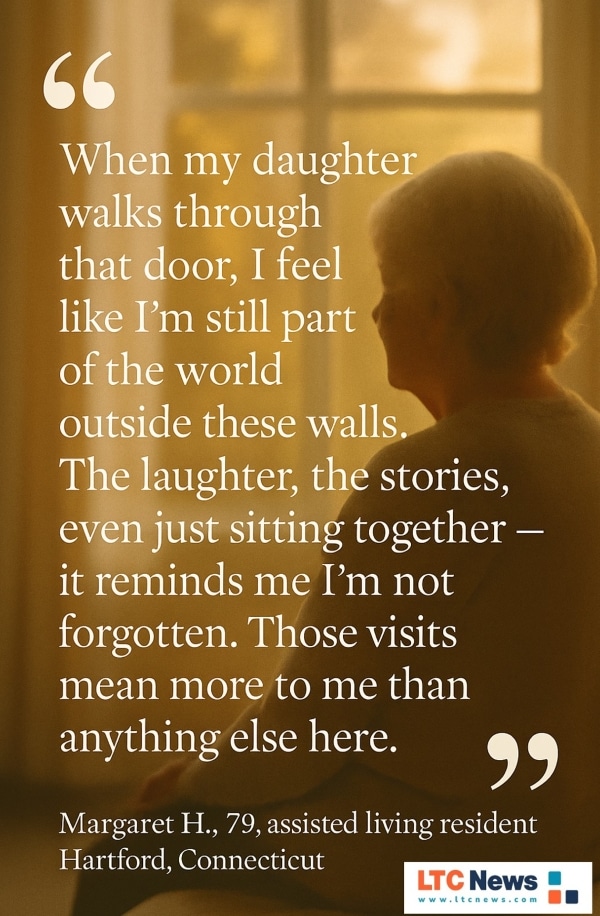How to Bring Comfort When Visiting Your Loved One in Assisted Living or Nursing Care

Walking into a nursing home or assisted living community for the first time to visit your mom, dad, or spouse can stir up a wave of emotions. You may feel nervous about what to say or guilty for not being there more often. Maybe you wonder if your visits even make much of a difference. The truth is, your presence matters more than you realize.
For someone living in long-term care, family visits are often the highlight of the day. They bring comfort, spark memories, and remind your loved one that they are still part of the family story.

Share your thoughts and experiences about aging, caregiving, health, and long-term care with LTC News —Contact LTC News.
But visiting can feel intimidating, especially if you’ve never done it before or if your loved one’s health has changed. By approaching each visit with empathy and planning, you can make the time meaningful for both of you.
Choosing the Right Time Matters
Timing isn’t just about following facility rules — it’s about meeting your loved one when they feel their best. Most residents have more energy earlier in the day, though every person is different. Ask the staff or your loved one when they feel most alert.
Showing up during those “good hours” helps you avoid interrupting medical care, meals, or rest. It also gives you a better chance of having a meaningful interaction — even if it’s just holding hands and sharing a quiet moment together.
- Explore further: Making assisted living visits more comfortable.
Bring a Piece of Home with You
Think about the little things that make your loved one smile: a photo of the grandkids, a favorite blanket, or even a piece of artwork from the family home. These familiar items soften the clinical feel of a facility and remind your loved one that they are loved, remembered, and connected to life outside those walls.
It doesn’t have to be something big. A small framed picture of a family vacation or a pillow with a favorite pattern can brighten their day in a deeply personal way.
Lead With Positivity and Patience
Your loved one may already be navigating daily challenges — from limited mobility to feelings of loneliness. When you walk in, you bring an atmosphere with you. Leading with warmth, patience, and positivity can lift the entire visit.
If you bring children, help prepare them for what they might see and remind them how much their visit means. Kids bring joy, but they also bring noise and energy. A little preparation helps keep things calm and enjoyable for everyone.
Make Visits Family-Friendly
For kids, nursing homes and assisted living communities can feel unfamiliar. Their natural energy may fade quickly if they get bored. Bringing activities can help. A deck of cards, a simple board game, or a digital photo slideshow can spark interaction across generations.
Snacks help, too — bringing an approved snack that your older loved one can enjoy, such as snack-sized trail mix portions or freeze-dried fruit snacks. Make sure your loved one’s healthcare team at the facility is aware of and on board with any snacks you provide, as certain ingredients can interfere with medications or health conditions.
Respect Their Energy
Even the most joyful visit can be tiring. Your loved one may not always have the stamina for a long stay, and that’s okay. Pay attention to their cues. If they seem restless, quiet, or eager to get back to their routine, don’t take it personally. It often means you’ve given them the enrichment they needed, and now they need to rest.
Short, frequent visits are often better than long ones. What matters is not the length of time, but the love and reassurance you bring.
Build Relationships with Staff
The caregivers you see during your visits are the people who spend the most time with your loved one each day. Building a rapport with them can give you insight into how your loved one is doing. Ask questions, share concerns, and listen to their advice.
Staff often know when your loved one is most alert or what small comforts help during the day. Partnering with them creates consistency — and your loved one will benefit from knowing you’re all on the same team.
If your loved one is in the process of transitioning to assisted living, memory care, or a nursing home, be sure to visit several facilities before committing.
Assisted living typically feels more like home than a traditional long-term care facility. When you begin the process of moving a loved one into an assisted living facility, the first conversation is usually with an intake coordinator or admissions director. This person explains the community’s services, answers family questions, and gathers initial background information.
After that, a nurse or clinical staff member will conduct a formal assessment of your loved one’s health and daily living needs. This review typically covers:
- Medical history and medications
- Mobility and fall risk
- Personal care needs (such as bathing, dressing, and eating)
- Cognitive health (memory concerns or signs of dementia)
- Nutritional needs and dietary restrictions
The assessment ensures the facility can provide the right level of care and helps develop a personalized care plan before admission.
If your loved one has a Long-Term Care Insurance policy, let the admissions director know right away. They can review the benefits and help coordinate payment. In many higher-quality facilities, having LTC coverage can also give your loved one priority access since the policy helps guarantee reliable funding for care.
Need help filing a claim? LTC News partners with Amada Senior Care to provide free LTC Insurance claim support with no cost or obligation. Their trained experts can walk you through the entire process and help you access benefits quickly and correctly — File a Long-Term Care Insurance Claim.
Connection Without Words
If your loved one is living with dementia, illness, or simply lower energy, conversations may not flow the way they used to. That can be hard, but connection doesn’t always require words.
Hold their hand. Sit together by the window. Look through an old photo album. Listen to music. Watch birds outside. Presence and touch can speak louder than any sentence. Sometimes, the most powerful moments happen in silence.
A loved one's quality of life does not have to diminish with family support and the quality of extended care they deserve.
A Visit That Truly Matters
You don’t need to have long talks or orchestrate perfect activities to make a difference. What your loved one will remember is how you made them feel. Loved. Seen. Part of the family.
Your visits are a lifeline, not just for them but for you, too. They remind you both that the bond you share doesn’t fade with age or illness — it simply changes. And in those moments, you’ll find comfort, connection, and meaning that lasts well beyond the visit.
Editor’s Note: Long-term care is part of life for millions of families. Planning now will help protect your income and savings and ensure access to your choice of quality care. Since health insurance, including Medicare, only pays for short-term skilled care, an LTC policy is a vital part of a comprehensive retirement plan. Use the LTC News Cost of Care Calculator to see what care costs in your area and how to prepare and seek professional help from a qualified LTC Insurance specialist to get accurate quotes and professional recommendations.


